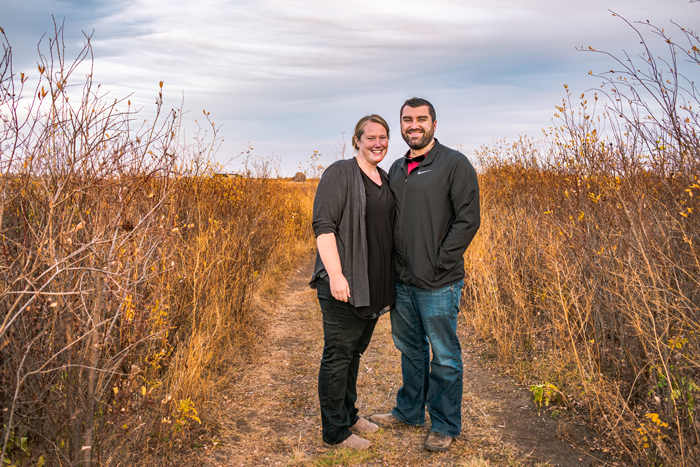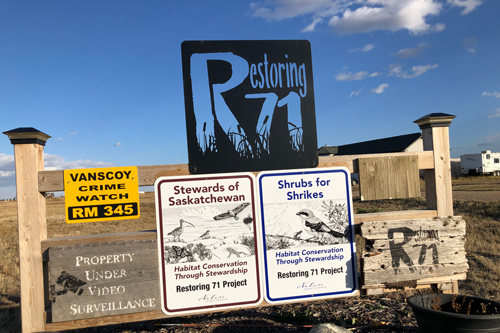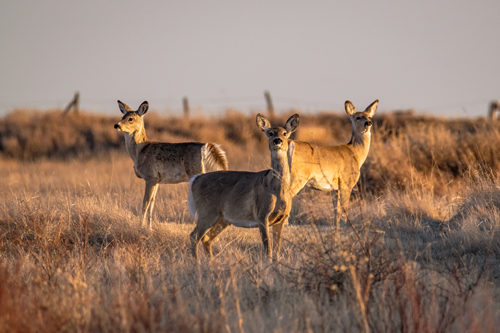
Returning to their roots
Katie and Aaron Suek are restoring 71 acres of their property into its natural state.
By John GraingerUnlike most people, Katie Suek (BA’06, MSEM'15) knows a whooping crane when she sees one.
That’s why after her husband, Aaron Suek (BSC’06), told her there was one strutting about nearly in their back yard, she was ecstatic. Seeing an endangered whooping crane so close to home was truly something special.
“To me, that was kind of an ah-ha moment,” said Katie. “Maybe it’s more than just ducks and geese here.”
“(Aaron’s) the engineer, so I gave him the numbers. This is one of 800 (whooping cranes left in the world). That’s impressive.”
Impressive, indeed.
The couple purchased their 80 acres in 2014 with the idea of restoring the land back to its original habitat. They kept the first nine acres to build their home and yard site, but have the remaining 71 to return to its more natural state.

The following spring, Aaron designed and mowed several kilometres of intertwining trails for better access to the site and started capturing local wildlife through photography and video. Thus, the Restoring 71 Project was born.
“We had access in place, folders of wildlife footage and a vague vision of what we wanted to accomplish, but seeing the whooping crane was the motivator, I guess, to get our butts into gear and really make this into a conservation project,” said Katie.
Katie, who works for Canada North Environmental Services as a human environment and community engagement specialist, saw their move back to the country, near Grandora, Sask., as a way to leave the hustle and bustle of suburbia and provide their three children with a lifestyle city kids often can’t experience.
“They don’t know how lucky they are. They just don’t realize it quite yet,” said Katie.
All three of their children, ages 10, 8, and 4, are learning daily and are quick to point out the plants or animal species they come across on their property. They even take an active role in naming some of the animals they come across, like Petunia the Porcupine.
A graduate of USask’s School of Environment and Sustainability (SENS), Katie didn’t really know what to expect when they uprooted their family to this new environment.
“I worked for years as an environmental consultant, so I was the one telling clients, ‘You need to conserve this, you can’t disturb this,’ but had never walked the talk myself. And then to actually get out here and see how plentiful just an old patch of re-naturalized crop land is was pretty astounding, pretty surprising.”

One other aspect which shocked the Sueks was the amount of at-risk species on the land.
“We’re finding more all the time,” said Katie.
In fact, the Sueks are keeping a tally of the wildlife on the land and have found some, besides the whooping crane, are threatened or are deemed a special concern. There’s everything from loggerhead shrike to the Harris’ sparrow and American badger on the project site. There are other sensitive species they have come across including osprey, great blue heron, turkey vultures, and a variety of others.
But the cool thing is Katie and Aaron just haven’t kept their project to themselves. They’ve opened their doors, so to speak, to the public and to anyone with an interest in what they are doing.

They have carved out four kilometres of trails on their land complete with signage and information along the routes highlighting some of the interesting features walkers might encounter.
They have even created an outdoor classroom, complete with tree stump seating, for groups like school classes, who make the trip to see Restoring 71.
In fact, they have launched a Facebook page, YouTube channel, Instagram account and regularly update what’s been seen and heard on the land. There’s even a map they have created highlighting the trails and providing guidance for those exploring the trails.
The trails are open year-round by appointment, as the wildlife changes just like the seasons. Some birds, for instance, will be around in the summer, some will stop by in the winter, and some are here year-round.
The land has changed also in their few years. When they arrived, there was a wetland complete with all sorts of aquatic flora and fauna. It has since dried up, but they know it will return to marshland again when weather conditions change. It’s all part of the cycle of nature, Suek said.

Katie said she’s honoured people are genuinely interested in what happens on the land.
“It really is exciting to share this with people,” she said.
They offer access to the trails and guided tours free of charge as this is not a money-making venture in any way for the Sueks. They just want to offer an opportunity for people to feel connected to nature, see what they see on a daily basis and share the experiences.
Little did Katie know that when she was taking her master’s in sustainable environmental management (MSEM), it would hit this close to home. Literally.
“The MSEM program was designed to bring students across multiple disciplines together to learn from each other and work collaboratively on solutions to environmental issues,” she said. “We learned how to problem solve by looking at things through multiple lenses. That skillset is definitely one that has helped me find success in community engagement, both in my career and my role here at Restoring 71."
Katie believes everyone can look for opportunities to return land to its natural state and contribute to conservation.
“It doesn’t matter if you have a small back yard or 1,000 acres, you can make a difference.”
So for now, Katie and Aaron will keep watching and learning from the land. Who knows? Maybe while Aaron is out on the trails monitoring species next year, he’ll see another whooping crane. He will be sure to have his camera ready.



